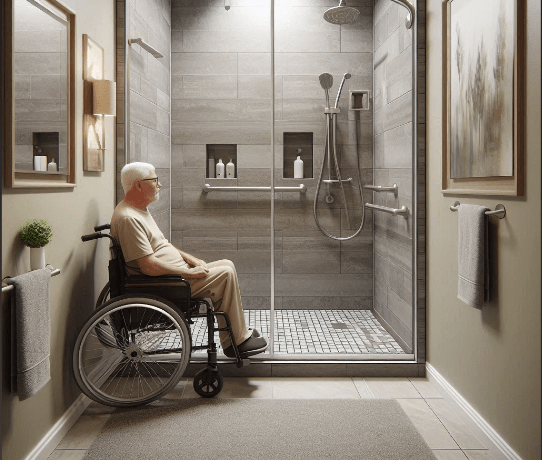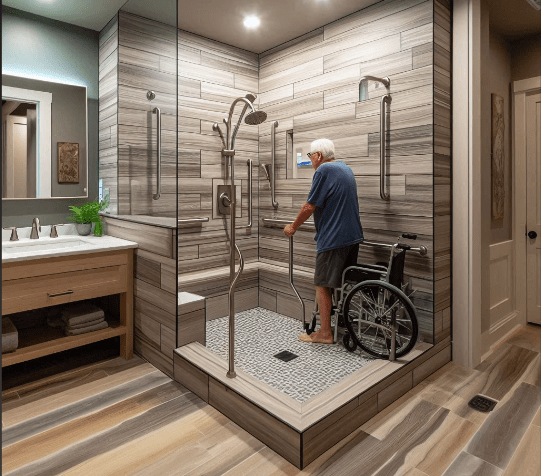1. What is Bathroom Remodel?
Remodeling a bathroom for a veteran involves more than just aesthetic upgrades. For many veterans, especially those with disabilities or mobility issues, an accessible bathroom is essential for maintaining independence and improving quality of life. This article explores the key considerations and options available when remodeling a bathroom to meet the specific needs of veterans.
2. Understanding the Needs of Veterans
Accessibility Requirements
Many veterans, particularly those who have sustained injuries during their service, require modifications to their living spaces to accommodate mobility challenges. Accessibility features such as walk-in showers, grab bars, and non-slip flooring are crucial for ensuring safety and ease of use in the bathroom.
Comfort and Usability
Beyond accessibility, comfort is a critical aspect of any bathroom remodel. Veterans may need specific features like adjustable showerheads, ergonomic fixtures, and seating options to make daily routines more manageable and comfortable.
3. Key Features of an Accessible Bathroom Remodel
Walk-In Showers and Bathtubs
Walk-in showers and bathtubs are essential for veterans with limited mobility. These features eliminate the need to step over a high ledge, reducing the risk of falls. Many models also include built-in seating and hand-held showerheads for added convenience.
Grab Bars and Handrails
Installing grab bars and handrails is a simple yet effective way to enhance bathroom safety. These fixtures should be strategically placed near the toilet, shower, and bathtub to provide support where it’s most needed.
Non-Slip Flooring
Slippery surfaces are a common hazard in bathrooms. Non-slip flooring materials, such as textured tiles or vinyl, can significantly reduce the risk of falls. These materials also come in various styles, allowing you to maintain the bathroom’s aesthetic appeal.
4. Specialized Fixtures and Accessories
Adjustable Showerheads
Adjustable showerheads are particularly beneficial for veterans with varying mobility levels. These showerheads can be moved up or down to accommodate standing or seated use, making the showering process more comfortable and flexible.
Raised Toilet Seats
For veterans with difficulty sitting or standing, a raised toilet seat can make a significant difference. These seats are higher than standard toilets, reducing the strain on the knees and hips during use.
Accessible Vanities and Sinks
Accessible vanities and sinks should be designed with wheelchair users in mind. These fixtures typically have open space underneath to accommodate a wheelchair and are set at a height that allows easy reach from a seated position.
5. Funding and Assistance for Veterans
VA Grants and Programs
The Department of Veterans Affairs (VA) offers several grants and programs to assist veterans with home modifications. Programs like the Specially Adapted Housing (SAH) grant can help cover the costs of bathroom remodels that meet specific accessibility needs.
Nonprofit Organizations
Various nonprofit organizations also provide assistance to veterans in need of home modifications. These organizations often partner with local contractors to offer services at reduced costs or even free of charge.
6. Choosing the Right Contractor
Experience with Accessible Remodels
When selecting a contractor for a veteran’s bathroom remodel, it’s essential to choose one with experience in accessibility-focused projects. A contractor who understands the unique needs of veterans can provide valuable insights and ensure that the remodel meets all necessary standards.
Collaborating with Veterans’ Groups
Collaborating with veterans’ groups during the planning and execution of a bathroom remodel can ensure that the specific needs of the veteran are fully understood and addressed. These groups can also provide recommendations for contractors and suppliers who specialize in accessible home modifications.
7. Future-Proofing the Bathroom
Universal Design Principles
Incorporating universal design principles into a bathroom remodel ensures that the space remains functional and accessible as the veteran’s needs evolve. Features like adjustable countertops, wide doorways, and lever-style handles are just a few examples of how a bathroom can be future-proofed.
Consideration for Aging Veterans
As veterans age, their needs may change, making it important to anticipate and accommodate these changes during the remodel. Planning for potential future mobility issues by installing extra support structures or choosing adaptable fixtures can help avoid the need for further renovations down the line.
Understanding the Needs of Disabled Veterans
Remodeling a bathroom for a disabled veteran requires careful planning and consideration. Veterans may have specific physical challenges that demand specialized solutions. It is essential to create a space that is both functional and accessible, ensuring comfort and safety.
Prioritize Accessibility
Accessibility should be the primary focus when remodeling a bathroom for a disabled veteran. Install grab bars near the toilet and shower to provide support. Consider a walk-in shower with a bench, allowing for ease of use. Lowering the sink and installing lever handles on faucets can make daily tasks more manageable.
Choose Slip-Resistant Flooring
Selecting the right flooring is crucial in a bathroom remodel for disabled veterans. Slip-resistant flooring can prevent falls and provide a stable surface. Options like textured tiles or vinyl with a non-slip finish are ideal. Ensure the flooring is also easy to clean and maintain.
Consider Widening Doorways
Wider doorways are often necessary for wheelchair access. Standard doorways may not provide enough space for easy navigation. By widening the doorways, you can ensure that the bathroom is accessible to all, regardless of mobility challenges.
Optimize Lighting for Safety
Proper lighting is vital in a bathroom remodel for disabled veterans. Well-lit spaces reduce the risk of accidents. Install motion-sensor lights or easily accessible switches to enhance visibility. Consider adding additional lighting around mirrors and in the shower area for maximum safety.
Install an Accessible Toilet
An accessible toilet is a key component of a bathroom remodel for disabled veterans. Raised toilets or those with adjustable heights can make a significant difference. Adding a bidet or toilet seat with built-in features like warm water or air drying can also enhance comfort and independence.
Incorporate Ample Storage Solutions
Storage is often overlooked in bathroom remodels, but it is crucial for disabled veterans. Consider installing pull-out shelves, easily reachable cabinets, and open shelving. These features allow veterans to access their necessities without straining or bending.
Work with a Professional Contractor
Hiring a professional contractor experienced in accessible remodeling is essential. They will understand the unique needs of disabled veterans and can offer solutions that comply with ADA guidelines. A skilled contractor ensures that the remodel is completed to the highest standard, providing peace of mind.
FAQs About Bathroom Remodel for Veterans
1. Why is a specialized bathroom remodel necessary for veterans?
Veterans, especially those with disabilities or injuries, often have unique needs that require specialized accommodations. A bathroom remodel ensures that the space is accessible, safe, and functional, allowing veterans to maintain independence and comfort in their daily routines.
2. What are the key features of an accessible bathroom remodel for veterans?
An accessible bathroom remodel typically includes features like grab bars, walk-in showers with benches, slip-resistant flooring, widened doorways, and accessible toilets. These elements help to create a safe environment that is easy to navigate and use.
3. How can I make a bathroom safer for a veteran with mobility issues?
To enhance safety, consider installing slip-resistant flooring, grab bars near the shower and toilet, a walk-in shower, and a bench. Good lighting, especially with motion sensors, can also reduce the risk of accidents. Additionally, ensuring that the space is free of clutter and has easy-to-reach storage is essential.
4. Are there specific guidelines to follow when remodeling a bathroom for disabled veterans?
Yes, the Americans with Disabilities Act (ADA) provides guidelines for accessible design. These guidelines cover aspects like door width, toilet height, and the placement of grab bars. Working with a contractor familiar with ADA regulations ensures that the remodel meets these standards.
5. What type of flooring is best for a veteran’s bathroom remodel?
Slip-resistant flooring is ideal for a veteran’s bathroom. Textured tiles, vinyl with a non-slip finish, or rubber flooring are good options. These materials provide stability, reduce the risk of falls, and are easy to clean and maintain.
6. How can I make a bathroom more accessible for veterans who use wheelchairs?
To accommodate wheelchairs, ensure that the bathroom has wide doorways, a roll-in shower, and a lowered sink. Consider installing lever-style faucets and accessible storage solutions. Removing obstacles and ensuring there is enough space to maneuver is crucial.
7. Is financial assistance available for veterans who need a bathroom remodel?
Yes, several programs offer financial assistance for veterans who need home modifications. The VA offers grants like the Specially Adapted Housing (SAH) grant and the Home Improvements and Structural Alterations (HISA) grant, which can be used for bathroom remodels.
8. Can I do the remodel myself, or should I hire a professional?
While some aspects of a remodel can be done as DIY projects, hiring a professional contractor experienced in accessible design is recommended. They can ensure that the remodel meets ADA guidelines and addresses the specific needs of the veteran.
9. How long does a bathroom remodel for a veteran typically take?
The timeline for a bathroom remodel varies depending on the complexity of the project. On average, it can take anywhere from a few weeks to a couple of months. Working with an experienced contractor can help streamline the process and avoid delays.
10. What is the approximate cost of a bathroom remodel for a disabled veteran?
The cost of a bathroom remodel can vary widely depending on the scope of work, materials used, and location. On average, a basic remodel focusing on accessibility can range from $10,000 to $30,000. However, costs can be offset by grants or financial assistance programs available to veterans.
8. Conclusion
Remodeling a bathroom for a veteran is an opportunity to enhance both accessibility and comfort, ensuring that the space meets the unique needs of those who have served. By focusing on safety, usability, and future-proofing, you can create a bathroom that not only improves the veteran’s quality of life but also honors their service. Whether through VA grants, nonprofit assistance, or thoughtful design, a bathroom remodel can make a significant positive impact on the daily life of a veteran.